You are using an out of date browser. It may not display this or other websites correctly.
You should upgrade or use an alternative browser.
You should upgrade or use an alternative browser.
Crisis in the Kremlin - Our 1982 USSR
- Thread starter panpiotr
- Start date
-
- Tags
- 1980's communism soviet union ussr
Threadmarks
View all 31 threadmarks
Reader mode
Reader mode
Recent threadmarks
COMECON (1986) Chapter Nineteen: Internal reorganization (July - October 1986) USSR Sphere of Influence (1986) Chapter Twenty: A new wave in the Soviet politics (November 1986 - April 1987) 15 Largest economies by GDP (1987) Chapter Twenty One: The Helsinki Accord and Operation Magistral (May 1987 - January 1988) THE END Crisis in the Kremlin (Our 1988 USSR) - SequelMy bad... I thought all countries in Soviet Sphere are in COMECON. Otherwise here's the map of otl COMECON
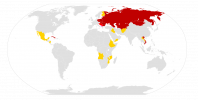
Red are member states, light red is Yugoslavia that was associate state that joined some organs but wasn't full member (the basis of the 1964 agreement, Yugoslavia participated in twenty-one of the thirty-two key Comecon institutions as if it were a full member) , purple for Albania that left in 1961, but withdrew formally in 1987 (so yea officially they were members, they just didn't participate in operations).
Finland, Mexico, Nicaragua and Iraq actually had cooperant status with Comecon, otherwise, other yellow states were observer states. Regarding COMECON its actually good that it has international/global element especially since it will help spread the use of Ruble as a world currency and help Soviets establish trade across the world while diminishing that of Western countries.
Otl it was based on voluntary participation and i imagine that it still is so, so even if we push for more centralization in WP non European countries have option not to participate, but even then its not guaranteed that we will as with WP and Brezhnev doctrine we have enough influence in Eastern Europe. Not to mention COMECON having more international and global element probably makes it more acceptable to WP countries as it won't be perceived as purely Soviet attempt to confederate them. Everything else we may want we can achieve with separate treaties.

Red are member states, light red is Yugoslavia that was associate state that joined some organs but wasn't full member (the basis of the 1964 agreement, Yugoslavia participated in twenty-one of the thirty-two key Comecon institutions as if it were a full member) , purple for Albania that left in 1961, but withdrew formally in 1987 (so yea officially they were members, they just didn't participate in operations).
Finland, Mexico, Nicaragua and Iraq actually had cooperant status with Comecon, otherwise, other yellow states were observer states. Regarding COMECON its actually good that it has international/global element especially since it will help spread the use of Ruble as a world currency and help Soviets establish trade across the world while diminishing that of Western countries.
Otl it was based on voluntary participation and i imagine that it still is so, so even if we push for more centralization in WP non European countries have option not to participate, but even then its not guaranteed that we will as with WP and Brezhnev doctrine we have enough influence in Eastern Europe. Not to mention COMECON having more international and global element probably makes it more acceptable to WP countries as it won't be perceived as purely Soviet attempt to confederate them. Everything else we may want we can achieve with separate treaties.
Last edited:
On the interesting note about COMECON , otl it had common institutions and cooperation but the problem was that it acted more like instrument of economic assistance than it was international trade system (which it was as it was literally nsmed Council for Mutual Economic Assistance).
Regarding reforms we implemented here are most important and impactful as well as how they should fair in our current system:
- decrease and elimination of trade barriers between member states;
Commecon trade worked on principle that it was negotiated between member states governments , then was followed with deals between companies. Basically it was included in confines of planned economies.
With Romanov reforms i imagine that synchronization of five year plans was improved and simplified to include general needs and goals of each country opposed to going into the details (basically it acts more as a guideline for all COMECON economies), while specialization of economy was discarded in favor of diversification with member state's opening their markets to each others products, with tarifs being set, or lowered on the goods every member needs and them being negotiated in advance. Not to mention bilateral deals were supplemented by multilateral deals.
This in turn would simplify central planing and trade as you only want bigger access to the market opposed to specifying how much and what you want to produce
- deregulation of prices on goods procured from trade;
COMECON had set prices different from world market as agreed between various member state's. This in later years was good for USSR as it enabled it to sell its oil at fixed rates at higher prices than world market (though before that USSR was actually selling below market price). I imagine that prices would be set more realistically here based on price of the product opposed to negotiated prices (though some exceptions could be made). On one hand this is bad for USSR as now it needs to sell its oil at market price, but on other hand it's good for other Warsaw Pact economies (it's good that we stabilized oil prices). But given that we gave up specialization of economy USSR is free to compete in COMECON market and as it's larges economy it should preform well.
- establishment of as many common institutions across the newly created market as possible to disincentivize the dissolution of COMECON;
COMECON had quite a bit of common institutions, what this would entail in new reforms is restructuring and increasing importance of The Council Committee for Cooperation in Planning to enable better coordination between various five years plans between member states to make it true COMECON supranational planning body and not make it subjected to national approval as much as multilateral goals and deals which would be set by Executive committee to execute in practice (this body would generally follow directives of the Session of COMECON).
Basically it's not as much as establishing New institutions as it's about reforming existing ones to work in more international framework. I suppose if something new needs to be established it's Commission for trade and consumer quality.
Generally as we can see much of the reforms are atm in confines of Central planing, but with introduction of Mixed economy COMECON will probably be able to digest them more efficiently.
Other reforms of Comrade Romanov include:
- expansion of the student exchange program with a focus on the USSR as the target for exchange;
- establishment of a series of consumer standards for trade goods;
- creation of a standardized system of logos that will represent the origin of any given product;
- expansion of tourist programs.
Regarding reforms we implemented here are most important and impactful as well as how they should fair in our current system:
- decrease and elimination of trade barriers between member states;
Commecon trade worked on principle that it was negotiated between member states governments , then was followed with deals between companies. Basically it was included in confines of planned economies.
With Romanov reforms i imagine that synchronization of five year plans was improved and simplified to include general needs and goals of each country opposed to going into the details (basically it acts more as a guideline for all COMECON economies), while specialization of economy was discarded in favor of diversification with member state's opening their markets to each others products, with tarifs being set, or lowered on the goods every member needs and them being negotiated in advance. Not to mention bilateral deals were supplemented by multilateral deals.
This in turn would simplify central planing and trade as you only want bigger access to the market opposed to specifying how much and what you want to produce
- deregulation of prices on goods procured from trade;
COMECON had set prices different from world market as agreed between various member state's. This in later years was good for USSR as it enabled it to sell its oil at fixed rates at higher prices than world market (though before that USSR was actually selling below market price). I imagine that prices would be set more realistically here based on price of the product opposed to negotiated prices (though some exceptions could be made). On one hand this is bad for USSR as now it needs to sell its oil at market price, but on other hand it's good for other Warsaw Pact economies (it's good that we stabilized oil prices). But given that we gave up specialization of economy USSR is free to compete in COMECON market and as it's larges economy it should preform well.
- establishment of as many common institutions across the newly created market as possible to disincentivize the dissolution of COMECON;
COMECON had quite a bit of common institutions, what this would entail in new reforms is restructuring and increasing importance of The Council Committee for Cooperation in Planning to enable better coordination between various five years plans between member states to make it true COMECON supranational planning body and not make it subjected to national approval as much as multilateral goals and deals which would be set by Executive committee to execute in practice (this body would generally follow directives of the Session of COMECON).
Basically it's not as much as establishing New institutions as it's about reforming existing ones to work in more international framework. I suppose if something new needs to be established it's Commission for trade and consumer quality.
Generally as we can see much of the reforms are atm in confines of Central planing, but with introduction of Mixed economy COMECON will probably be able to digest them more efficiently.
Other reforms of Comrade Romanov include:
- expansion of the student exchange program with a focus on the USSR as the target for exchange;
- establishment of a series of consumer standards for trade goods;
- creation of a standardized system of logos that will represent the origin of any given product;
- expansion of tourist programs.
Last edited:
Well the Partido Nacional Revolucionario ("National Revolutionary Party) ruled for nearly 70 years OTL and was founded as a coalition of surviving leaders of the Mexican Revolution (1910 to 1920) and was a member of the Socialist International.Wait Mexico was a COMECON observer?
Mexican Communist revolution when?
COMECON (1986)
so like this? hope I did not miss anyone?COMECON members:
Bulgaria
Cuba
Czechoslovakia
East Germany
Hungary
Mongolia
Poland
USSR
Vietnam
South Yemen
Libya
Syria
Albania
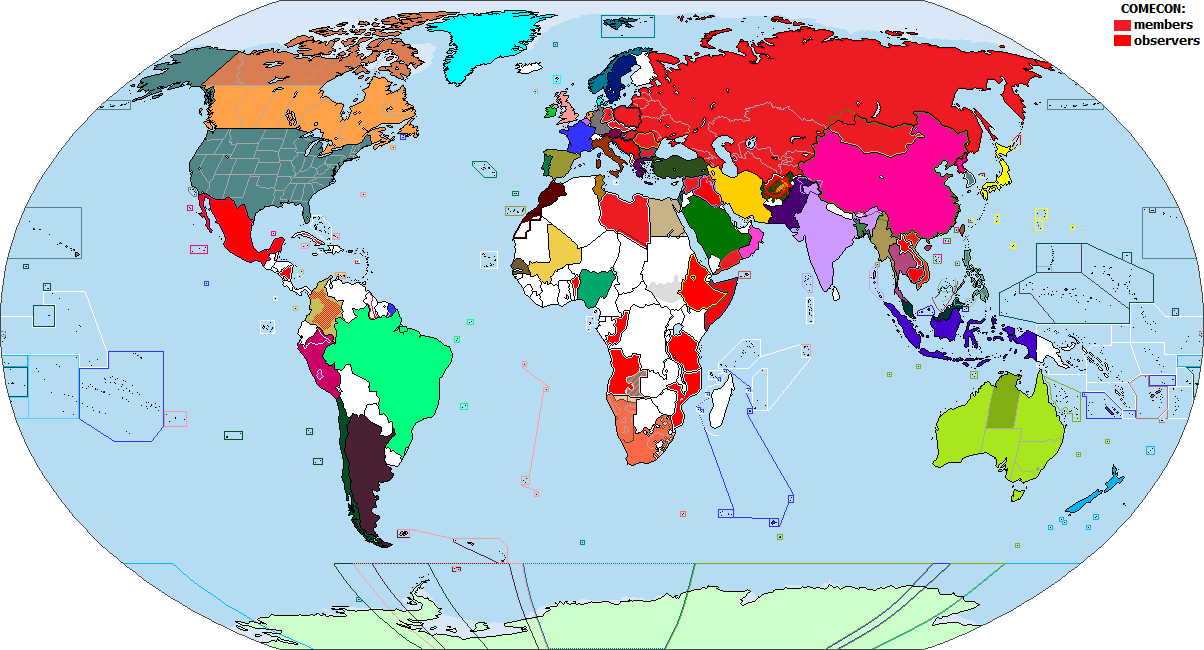
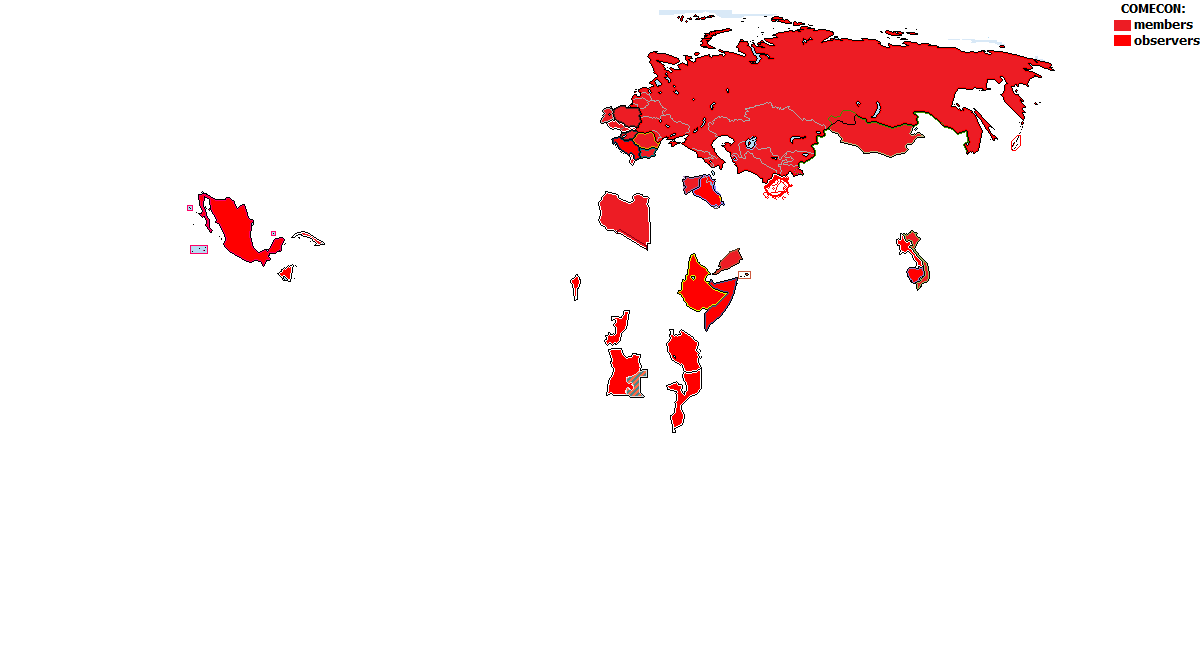
You missed Upper Volta/Burkina Faso.so like this? hope I did not miss anyone?


That was neither on the list or the COMECON map (or I am going blind, don't get me wrong my female half tells me that for years now for not finding stuff she puts away ...You missed Upper Volta/Burkina Faso.
Honestly, I'd like to increase relations with Mexico and maybe their membership in COMECON since I'd rather Mexico not be part of the NAFTA deal...
Unlikely to happen as it's to close to the US so it's likely that US won't allow it nor will Mexico risk it as USA is probably more important trading partner that USSR so Mexico cannot really afford to alienate USA but that doesn't stop it from pursuing closer relations with USSR and COMECON . Maybe upgrade to associate member? As for NAFTA even if it gets signed it will probably be different than otl and more in Mexican favor.
so like this? hope I did not miss anyone?


Kinda hard to differentiate who's COMECON members, but it represents Soviet sphere of influence nicely.
Otherwise you should add Chad since at the time it was invaded by Libya so with Libyan ascension to COMECON its pro Soviet state (partly).
Last edited:
It is more different in paint tbh not sure if some of the colors change when uploading them or saving the image? Might use more contrasting one in light and dark next time. Reguarding the map there is a ton of countries missing the Soviets OTL also had naval, air and troop station rights outside of this core group like Algeria, Mali, Kenia, Gabun, but I wasn't to certain how to best visualize that. On top of that otehr bilateral treaties and agreements with Egypt, Iran, India, China and Finnland existed outside of the Warshaw Pact and COMECON.Kinda hard to differentiate who's COMECON members, but it represents Soviet sphere of influence nicely.
Yeah but that's for a overall world and occupation map no full member I would argue, will wait what the autor has to say about that. ;DOtherwise you should add Chad since at the time it was invaded by Libya so with Libyan ascension to COMECON its pro Soviet state (partly).
Last edited:
Ah ok, hopefully Mexico comes out better than OTL...Unlikely to happen as it's to close to the US so it's likely that US won't allow it nor will Mexico risk it as USA is probably more important trading partner that USSR so Mexico cannot really afford to alienate USA but that doesn't stop it from pursuing closer relations with USSR and COMECON . Maybe upgrade to associate member? As for NAFTA even if it gets signed it will probably be different than otl and more in Mexican favor.
It was mentioned in the previous page.That was neither on the list or the COMECON map (or I am going blind, don't get me wrong my female half tells me that for years now for not finding stuff she puts away ...
This is just the COMECON maps, Soviet Sphere of overall influence will follow tomorrow or at the weekend. ;DIt was mentioned in the previous page.
Also thanks overall as I have so few RL tiem to do even my own AU/TL that it gets easy to overlook a few things in ones i read, or even do maps for from tiem to time, ecpecially with the Halloween Party planning coming up...
I first want to know how different Warsaw Pact and COMECON should be colored on that map, or if all Soviet Sphere areas should have the same coloring, also what to do about the overall existing naval, air and troop station rights outside of this core group like Algeria, Mali, Kenia, Gabun, but I wasn't to certain how to best visualize that. On top of that otehr bilateral treaties and agreements with Egypt, Iran, India, China and Finnland existed outside of the Warshaw Pact and COMECON, as it is influence, but not so direct one.
While we are at it I'm not certain if areas of control in Afghanistan and Angola are still correct and up to date in this TL by now, so any help there woudl be aprpeciated.
Last edited:
It is more different in paint tbh not sure if some of the colors change when uploading them or saving the image? Might use more contrasting one in light and dark next time. Reguarding the map there is a ton of countries missing the Soviets OTL also had naval, air and troop station rights outside of this core group like Algeria, Mali, Kenia, Gabun, but I wasn't to certain how to best visualize that. On top of that otehr bilateral treaties and agreements with Egypt, Iran, India, China and Finnland existed outside of the Warshaw Pact and COMECON.
Thats true. Finland was generally neutral, but pursued pro Soviet policies, it was also cooperant to COMECON. Generally that's the problem with Spheres of influence, same with Mexico. While map says it was observer wiki says it was actually Cooperant like Finland.
Yugoslavia was associate but was neutral, Romania was in Warsaw Pact and COMECON, but is probably still quite autonomous. So countries had different relationships with USSR.
Egypt relationship with Soviets in this time period worsened due to Egyptian support for Mujahideen after Soviet invasion and were severed in 1981, but reestablished in 1984. But generally Egypt isn't weary pro Soviet in this time period, though they could be on upswing.
Iran is probably better than otl since we are selling them weapons to defend from Irak etc.
This is just the COMECON maps, Soviet Sphere of overall influence will follow tomorrow or at the weekend. ;D
Also thanks overall as I have so few RL tiem to do even my own AU/TL that it gets easy to overlook a few things in ones i read, or even do maps for from tiem to time, ecpecially with the Halloween Party planning coming up...
I first want to know how different Warsaw Pact and COMECON should be colored on that map, or if all Soviet Sphere areas should have the same coloring, also what to do about the overall existing naval, air and troop station rights outside of this core group like Algeria, Mali, Kenia, Gabun, but I wasn't to certain how to best visualize that. On top of that otehr bilateral treaties and agreements with Egypt, Iran, India, China and Finnland existed outside of the Warshaw Pact and COMECON, as it is influence, but not so direct one.
While we are at it I'm not certain if areas of control in Afghanistan and Angola are still correct and up to date in this TL by now, so any help there woudl be aprpeciated.
Generally Finland should be included due to lose association here.
Many thanks!so like this? hope I did not miss anyone?


Also regarding Soviet sphere of influence @panpiotr i believe you forgot to mention People's republic of Congo founded in 1969.
Generally this was otl sphere of influence
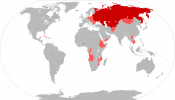
A change from otl was that instead Cambodia (which shifted to more neutral due to deal with China) we have added Libya, Syria ,Albania and Burkina Faso to our sphere.
This is more complete map of allegiances from otl.
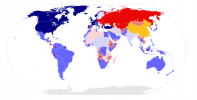
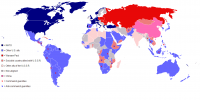
Generally from these two maps we can glean allegiances of various states in otl which shouldn't be that different ITTL, except with Lybia,Syria and Yemen + Albania/Burkina Faso being closer to Soviet sphere and Cambodia being neutral.
India is more closer to Soviets like in second map but Africa should be reflected more correctly in first map.
Regarding Somalia it was Soviet ally until Oganden war at which point Soviets decided to back Ethiopia over Somalia with Somalia shifting to Western block from 1970s onwards so i don't think they are in Soviet Sphere as of now.
Generally this was otl sphere of influence

A change from otl was that instead Cambodia (which shifted to more neutral due to deal with China) we have added Libya, Syria ,Albania and Burkina Faso to our sphere.
This is more complete map of allegiances from otl.


Generally from these two maps we can glean allegiances of various states in otl which shouldn't be that different ITTL, except with Lybia,Syria and Yemen + Albania/Burkina Faso being closer to Soviet sphere and Cambodia being neutral.
India is more closer to Soviets like in second map but Africa should be reflected more correctly in first map.
Regarding Somalia it was Soviet ally until Oganden war at which point Soviets decided to back Ethiopia over Somalia with Somalia shifting to Western block from 1970s onwards so i don't think they are in Soviet Sphere as of now.
Last edited:
oh yeah, I completely forgot about themAlso regarding Soviet sphere of influence @panpiotr i believe you forgot to mention People's republic of Congo founded in 1969.
They are due to our much increased tradeRegarding Somalia it was Soviet ally until Oganden war at which point Soviets decided to back Ethiopia over Somalia with Somalia shifting to Western block from 1970s onwards so i don't think they are in Soviet Sphere as of now.
Threadmarks
View all 31 threadmarks
Reader mode
Reader mode
Recent threadmarks
COMECON (1986) Chapter Nineteen: Internal reorganization (July - October 1986) USSR Sphere of Influence (1986) Chapter Twenty: A new wave in the Soviet politics (November 1986 - April 1987) 15 Largest economies by GDP (1987) Chapter Twenty One: The Helsinki Accord and Operation Magistral (May 1987 - January 1988) THE END Crisis in the Kremlin (Our 1988 USSR) - Sequel
Share: